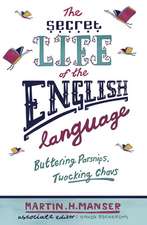Atmospheric Methane: Its Role in the Global Environment
Editat de Mohammad Aslam Khan Khalilen Limba Engleză Paperback – 8 dec 2010
| Toate formatele și edițiile | Preț | Express |
|---|---|---|
| Paperback (1) | 1195.03 lei 6-8 săpt. | |
| Springer Berlin, Heidelberg – 8 dec 2010 | 1195.03 lei 6-8 săpt. | |
| Hardback (1) | 1201.23 lei 6-8 săpt. | |
| Springer Berlin, Heidelberg – 23 ian 2000 | 1201.23 lei 6-8 săpt. |
Preț: 1195.03 lei
Preț vechi: 1457.35 lei
-18% Nou
Puncte Express: 1793
Preț estimativ în valută:
228.75€ • 240.13$ • 188.96£
228.75€ • 240.13$ • 188.96£
Carte tipărită la comandă
Livrare economică 30 ianuarie-13 februarie 25
Preluare comenzi: 021 569.72.76
Specificații
ISBN-13: 9783642084515
ISBN-10: 3642084516
Pagini: 360
Ilustrații: VII, 351 p.
Dimensiuni: 155 x 235 x 19 mm
Greutate: 0.5 kg
Ediția:Softcover reprint of hardcover 1st ed. 2000
Editura: Springer Berlin, Heidelberg
Colecția Springer
Locul publicării:Berlin, Heidelberg, Germany
ISBN-10: 3642084516
Pagini: 360
Ilustrații: VII, 351 p.
Dimensiuni: 155 x 235 x 19 mm
Greutate: 0.5 kg
Ediția:Softcover reprint of hardcover 1st ed. 2000
Editura: Springer Berlin, Heidelberg
Colecția Springer
Locul publicării:Berlin, Heidelberg, Germany
Public țintă
ResearchDescriere
Methane is an important greenhouse gas that can cause global warming. The present concentrations of methane are nearly three times higher than several hundred years ago. Today, more than 60% of the atmospheric methane comes from human activities, including rice agriculture, coal mining, natural gas usage, biomass burning, and raising of cattle. Methane affects the stratospheric ozone layer and the oxidizing capacity of the atmosphere, which in turn control the concentrations of many man-made and natural gases in the atmosphere. This book brings together our knowledge of the trends and the causes behind the increased levels of methane. Based on the scientific information on the sources and sinks, and the role of methane in global warming, strategies to limit emissions can be designed as part of a program to control future global warming.
Cuprins
1 Atmospheric Methane: An Introduction.- Record of Atmospheric Methane.- 2 The Ice Core Record of Atmospheric Methane.- 3 The Isotopic Composition of Atmospheric Methane and Its Sources.- Formation and Consumption of Methane.- 4 Biological Formation and Consumption of Methane.- Sources and Sinks.- 5 Can Stable Isotopes and Global Budgets Be Used to Constrain Atmospheric Methane Budgets?.- 6 Methane Sinks, Distributions, and Trends.- 7 Sources of Methane: An Overview.- Methane Emissions from Individual Sources.- 8 Ruminants and Other Animals.- 9 Rice Agriculture: Factors Controlling Emissions.- 10 Rice Agriculture: Emissions.- 11 Biomass Burning.- 12 Wetlands.- 13 Waste Management.- 14 Fossil Fuel Industries.- 15 Geological Sources of Methane.- The Environmental Role of Methane and Current Issues.- 16 Methane in the Global Environment.
Textul de pe ultima copertă
Methane is an important greenhouse gas that can cause global warming. The present concentrations of methane are nearly three times higher than several hundred years ago. Today, more than 60% of the atmospheric methane comes from human activities, including rice agriculture, coal mining, natural gas usage, biomass burning, and raising of cattle. Methane affects the stratospheric ozone layer and the oxidizing capacity of the atmosphere, which in turn control the concentrations of many man-made and natural gases in the atmosphere. This book brings together our knowledge of the trends and the causes behind the increased levels of methane. Based on the scientific information on the sources and sinks, and the role of methane in global warming, strategies to limit emissions can be designed as part of a program to control future global warming.






![Famous Last Words, Fond Farewells, Deathbed Diatribes, and Exclamations Upon Expiration: The Mysterious Landscapes of the Red Planet [With Poster]](https://i4.books-express.ro/bt/9780761126096/famous-last-words-fond-farewells-deathbed-diatribes-and-exclamations-upon-expiration.jpg)
